
Rebutia is a genus of flowering plants in the family Cactaceae, native to Bolivia and Argentina. The limits of the genus have varied widely, depending on whether genera such as Aylostera and Weingartia are included or treated separately. As of December 2024, Plants of the World Online accepted only three species of Rebutia. A very large number of plants that have been treated in cultivation as species of Rebutia are now generally regarded as varieties, forms or synonyms of a much smaller number of species, or have been transferred to other genera. Plants treated as Rebutia are generally small, colorful cacti, globular in form, which freely produce flowers that are relatively large in relation to the body. They have no distinctive ribs, but do have regularly arranged small tubercles. They are considered fairly easy to grow and they may produce large quantities of seeds that germinate freely around the parent plant.

Weingartia is a genus in the family Cactaceae, with species native to Bolivia and Argentina. It was formerly included in Rebutia, but molecular phylogenetic evidence suggested that it was distinct from that genus. As of December 2024, it was treated as separate genus by Plants of the World Online, and recognized as an alternative generic name in the third edition of the CITES Cactaceae Checklist. It may also be treated as Rebutia subg. Weingartia.

Rebutia minuscula is a species of cactus from South America found in northern Argentina and Bolivia. It is the type species of the genus Rebutia. As its synonym Rebutia senilis it has gained the Royal Horticultural Society's Award of Garden Merit. Its cultivars 'Krainziana', 'Marsoneri' and 'Violaciflora' are also listed as having gained the Award of Garden Merit.
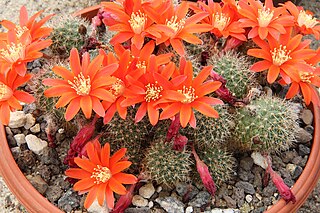
Aylostera fiebrigii, the orange crown cactus or flame crown, is a species of flowering plant in the cactus family that is native to exposed rocky plateaux in the Bolivean Andes, at altitudes of 2,100–4,000 m (6,900–13,100 ft) above sea level. It consists of a solitary ball some 15 cm (5.9 in) in diameter, covered in tubercles and silky hairs, with brilliant orange daisy-like flowers. In time these balls multiply to form mounds.
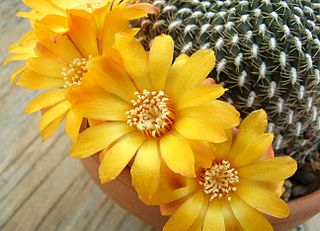
Weingartia arenacea, the arenaceous crown cactus, is a species of cactus native to central Bolivia. It has been renamed Weingartia arenacea. It has gained the Royal Horticultural Society's Award of Garden Merit.
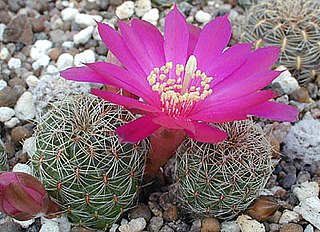
Weingartia canigueralii is a species of cactus in the genus Weingartia, native to Bolivia. It has gained the Royal Horticultural Society's Award of Garden Merit.

Weingartia mentosa, the crown cactus, is a species of cactus in the genus Weingartia, native to Bolivia. It has gained the Royal Horticultural Society's Award of Garden Merit.

Weingartia neocumingii, the Cuming crown cactus, is a species of cactus in the genus Weingartia, endemic to Bolivia. It has gained the Royal Horticultural Society's Award of Garden Merit.

Weingartia steinbachii, called Steinbach's crown cactus, is a species of cactus in the genus Weingartia, native to Bolivia. It has gained the Royal Horticultural Society's Award of Garden Merit.
Weingartia corroana is a species of flowering plant in the family Cactaceae, native to Bolivia. It was first described by Martín Cárdenas in 1951 as Weingartia pulquinensis var. corroana and then raised to a full species in 1964.
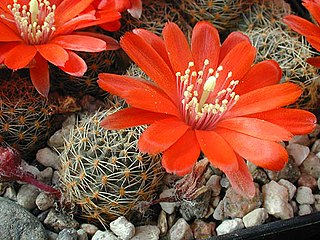
Aylostera pygmaea, synonyms including Rebutia pygmaea, is a species of cactus in the genus Aylostera, native to Bolivia and northwest Argentina. It has gained the Royal Horticultural Society's Award of Garden Merit.
Weingartia taratensis is a species of flowering plant in the family Cactaceae, native to Bolivia. It was first described by Martín Cárdenas in 1964 as Rebutia taratensis.

Weingartia cintia is a small alpine cactus native to the high Andes of Bolivia. The plant was discovered by Karel Kníže in 1969 at an elevation of 4,000 m (13,000 ft) near Otavi, in Potosí Department, Bolivia. However, it was not formally described until 1996 by Jan Říha. The genus is named after the town of Cinti in Chuquisaca Department.
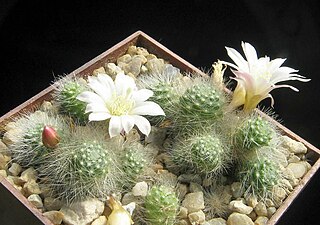
Aylostera albiflora, synonym Rebutia albiflora, is a species of flowering plant in the family Cactaceae, native to Bolivia. It was first described by Curt Backeberg in 1963 as Rebutia albiflora.
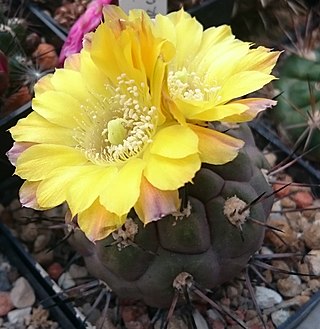
Weingartia fidana is a species of Weingartia found in Bolivia.

Weingartia cardenasiana is a species of Weingartia found in Bolivia.

Weingartia cylindrica is a species of Weingartia found in Bolivia.

Rebutia fabrisii is a species of Rebutia found in Argentina.
Weingartia glomeriseta is a species of Weingartia found in Bolivia.
Weingartia tarijensis is a species of Weingartia found in Bolivia.
















